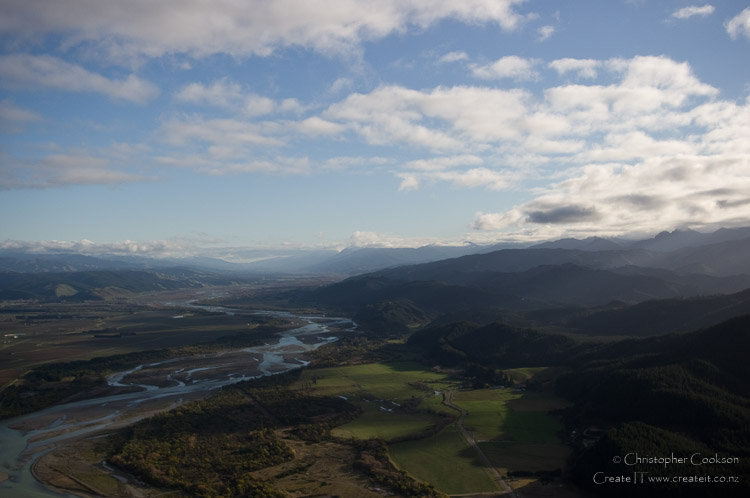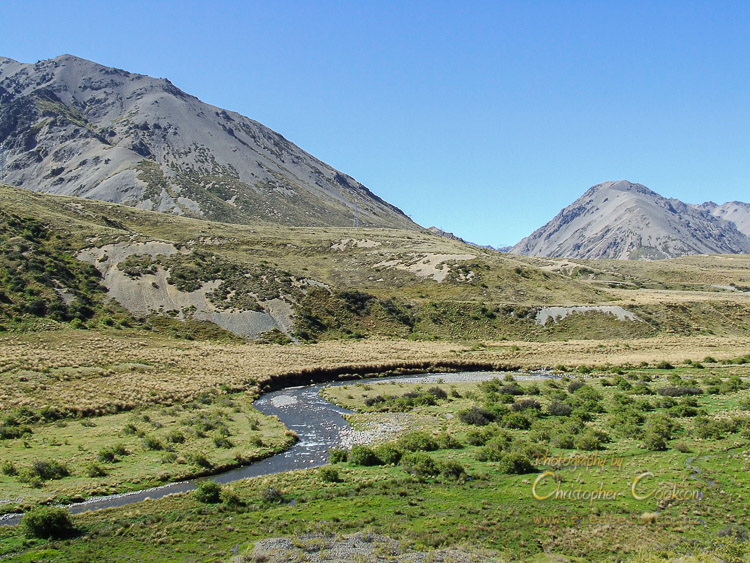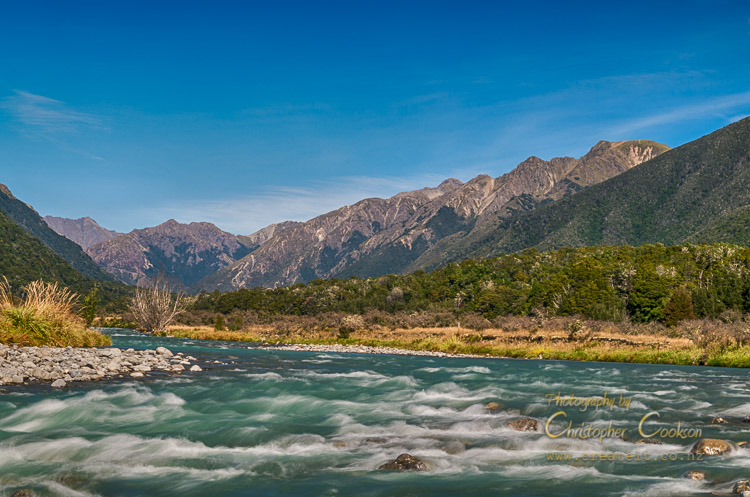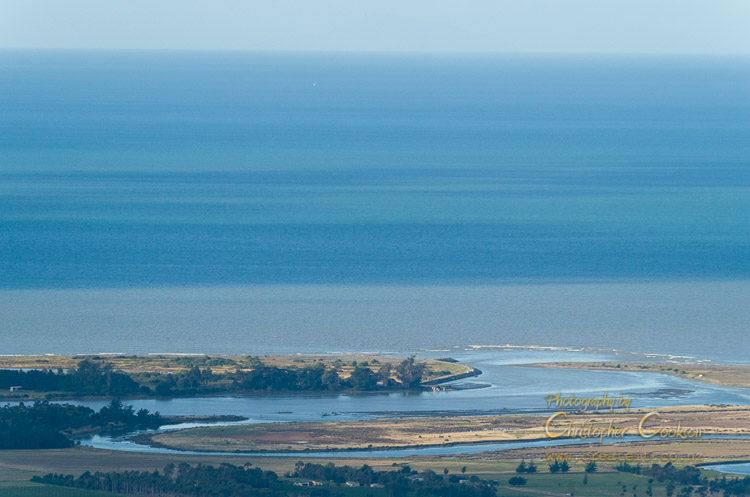Wairau River
Last Modified: 21-11-2020 22:31
By: Christopher Cookson

© Christopher Cookson License this image
The Wairau River is Marlborough's largest river and among the 20 longest rivers in New Zealand. It has a catchment area of 3430 square kilometres (LAWA) which represents almost a third of Marlborough's land area, and is 170km long. Maori aptly named it "many waters" owing to it being largely a braided river. Major tributaries include the Branch, the Waihopai and Rainbow rivers. The Wairau rises in the Spencer Mountains at an altitude of 2,202m and runs from the south to the north before turning north east to follow a part of the alpine fault line filled by glacial outwash. This leads more or less straight to the sea. A series of glacial moraine deposits west of Wairau Valley used to contain sizeable lakes before European times and signs of them can still be seen along the main road to Rotoiti. Most of the rock in the Wairau catchment is either hard, medium grained sandstone 'greywacke', or fine black mudstone 'argillite.
Most of the Wairau Plain was forested before humans arrived but with the advent of fire large areas on the eastern side were cleared and failed to regenerate. At the time Europeans arrived large areas of flax swamp and swamp forest covered the lower plains and the Wairau meandered freely amongst it. The north bank of the Wairau was almost entirely forested in mixed podocarp and broadleaf forest while the southern side was tall tussock grassland.
In its upper reaches where it flows between the St. Arnaud Range and the Raglan Range, the Wairau narrows into a gorge with a number of rapids.
In its middle reaches, from several kilometeres west of the Wash Bridge to downstream of the State Highway One bridge, the Wairau is a braided river with many channels and a broad, shingle bed.
In its lower reaches as it nears the sea, the Wairau forms a single channel and meanders to some extent, and Grovetown Lagoon is an oxbow lake formed by a former loop of the Wairau that was been cut off from the main channel during a flood.
The river enters the sea at the Wairau Bar where it flows into Cloudy Bay, and is navigable at high tide. Before entering the sea, the Wairau River feeds an extensive area of lagoons and salt marsh which is an important wildlife habitat, and originally an important source of food for Māori. The Wairau Lagoons walking track crosses the salt marsh to the wreck of the Waverley, a decommissioned steamer intended as a breakwater, but washed up a channel in 1928 and abandoned in the lagoons during a flood.
The Wairau River has historically been responsible for severe floods which have reached over 55000 cumecs. The most severe flood in the 20th Century occured in July 1983 when the river reached an estimated 5663 cumecs and a peak of 8.5m with Renwick, Spring Creek, and particularly Tuamarina flooded. Due to flooding problems, a second artificial outlet for the Wairau was created, the Wairau Diversion. The mouth of this channel has become a popular fishing and picnic spot.
The Wairau is crossed by four main bridges, The single lane Wash Bridge, on State Highway 63 between Renwick and Kawatiri, double lane bridge at Kaituna on State Highway 6 between Blenheim and Nelson, a double lane bridge on State Highway 1 at Tuamarina, and a single lane bridge at Spring Creek.
Ecology
The Wairau River provides an important habitat for a range of species. A number of bird species including variable oystercatcher, pied stilt, banded dotterel, black billed gull, and black fronted tern nest on sections of the Wairau riverbed, while numerous bird species can be found in and around the Wairau Lagoons. Salmon and trout have been introduced to the Wairau, while whitebait, eels and bully species can be found in the river and its tributaries. In the mid to lower reaches of the river, little to none of the original native vegeation remains, however in the mid to upper reaches, mānuka scrub and kānuka can be found along with scattered matagouri. In the Wairau gorge between the St. Arnaud and Raglan Ranges, beech forest becomes a significant part of the vegetation, before giving way to tussock grasslands at higher altitudes.
Commercial Use
The lower reaches of the river are navigable, and in the early years of European settlement, vessels used the Wairau as part of an important connection between Blenheim and Wellington. The last important merchant vessel that navigated the Wairau, the Echo , retired in the 1960s.
Water is taken from the Wairau to provide irrigation for vineyards on the Wairau Plain.Shingle is also taken from the river bed.
With growing electricity needs in the Marlborough region, an electricity generation company Trustpower, proposed a series of canals to take water from the Wairau to feed generators. There has been a considerable amount of public opposition to the proposal due to concerns over the effect on the environment, including potential loss of recreational fisheries. As of 2020 Trustpower has not proceeded with development.
Recreational Use
The Wairau River is used recreationally for trout fly fishing, jet boating, kayaking, swimming, rowing, and at its mouth, surf casting. Areas of the river bed, particularly near Renwick, are used by recreational vehicles.
In November 2020, the Marlborough District Council approved creation of the Wairau River Regional Park from the confluence of the Waihopai river to the Wairau's mouth.
Main Tributaries of the Wairau River
- Rainbow River
- Hamilton River
- Branch River
- Goulter River
- Wye River
- Marchburn River
- Waihopai River
- Spray River
- Avon River
- Teme River
- Tummil River
- Ohinemahuta (Onamalutu) River
- Waikakaho River
- Tuamarina River
References and Links
Wairau Mountain Lands: Marlborough Catchment Board and Regional Water Board Copyright 1980.
A River Ran Through It: Marlborough Express 15/7/2013
Images

© Christopher Cookson License this image

Beech forest becomes dominant in this part of the Wairau.
© Christopher Cookson License this image

Mouth of the Wairau River
© Christopher Cookson License this image
Web Links
Cite this page
Cookson, C. (2020). Wairau River. Retrieved April, 27, 2024, from https://www.marlboroughonline.co.nz/marlborough/information/geography/rivers/wairau-river/